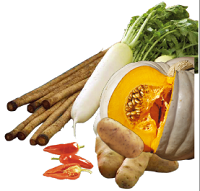Vegetable Recognition
 Gail Umehara / Wordsmith
Gail Umehara / Wordsmith
During her 16 years in Japan, Gail juggled raising a family with, amongst other things, working as a translation assistant, librarian, and editor. Back in Australia, she continues to work with words as an interpreter, editor and TAFE lecturer.
Vegetable Recognition
 Many of the plants we call vegetables when we eat them are, in botanical terms, actually fruits: this includes pumpkins, bell peppers, cucumbers, green beans, eggplants, and the well-known example of tomatoes. The botanical definition is based on the physical characteristics of the part of the plant being eaten, but in everyday life it's usually how we eat a plant that determines whether to look for it in the vegetable or fruit section in the supermarket. Late in the 19th century the US Supreme Court ruled that tomatoes are vegetables on the basis of culinary use. (Why was there a court case about this Importers had to pay customs duty on fruit, but not on vegetables!)
Many of the plants we call vegetables when we eat them are, in botanical terms, actually fruits: this includes pumpkins, bell peppers, cucumbers, green beans, eggplants, and the well-known example of tomatoes. The botanical definition is based on the physical characteristics of the part of the plant being eaten, but in everyday life it's usually how we eat a plant that determines whether to look for it in the vegetable or fruit section in the supermarket. Late in the 19th century the US Supreme Court ruled that tomatoes are vegetables on the basis of culinary use. (Why was there a court case about this Importers had to pay customs duty on fruit, but not on vegetables!)
There are many ways of classifying different types of vegetables. Commercial vegetable growers often identify their produce according to the part of the plant that is edible: root (e.g., carrots, radishes); tuber (the vast range of potatoes and yams); stem (asparagus); leaf (lettuce and other 'greens'); flower (broccoli); seed (peas); and, of course, fruit (okra, tomato, etc.). Particularly in organic and gourmet circles, another distinction is 'exotic/indigenous', but this creates many arguments.
Most countries do have their own 'native' vegetables, but they are usually a variation of a similar vegetable in other places, or were introduced through contact with other regions. The potato is a good example. Japan has always had native tubers, but the common potato that we all know arrived in Japan via the European colonies in Southeast Asia in the 17th century, and was given the name jaga-imo (Jakarta potato). An even earlier arrival is the Japanese pumpkin, kabocha, given the name of the country it was brought from in the 16th century, Kampuchea or Cambodia. Since then, Japanese farmers have nurtured and improved these plants to the point that every Japanese considers them to be Japanese.
One vegetable now considered uniquely Japanese, gobo (burdock), is a thistle taproot that grows throughout the Northern Hemisphere. The plant's seedpods were the inspiration for the development of Velcro, but its crisp texture and astringent flavor make it a favourite in Japanese home dishes.

